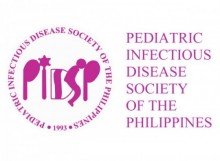1998 Journals
RATIONAL USE OF IMMUNOMODULARS IN PEDIATRICS
Prof. Lulu C. Bravo, MD *
Keywords: immunomodulators,immunoglobulins,corticosteriods,immunonutritionals,isoprinosine,IVIG,IG
| View Full Article in PDF format |
Maria Rosario Z. Capeding, MD,* Hanna Nohynek,* Luz G. Pascual,* Helena Kayhty,* Lydia T. Sombrero,* Juhani Eskola,* and Petri Ruutu*
Hib vaccine, antibody response, reactogenicity
| View Full Article in PDF format |
C.N. Maramba-Untalan,MD*, Lulu C. Bravo, MD*
Piperacillin/Tazobactam, gram negative bacilli, adverse events of Piperacillin/Tazobactam
Conclusions: Piperacillin/Tazobactam may be used as definitive or empiric therapy in pediatric patients with known resistance or poor response to standard antimicrobial therapy.
*Philippine General Hospital-University of the Philippines, College of Medicine **Presented at the Poster presentation of the 8th International Congress of Infectious Disease, Boston, USA, May 1998
| View Full Article in PDF format |
Celia C. Carlos, MD*
Keywords: antimicobial resistance enteric pathogens, respiratory tract pathogens, gram positive cocci, gram negative bacilli, N.gonorrhea
| View Full Article in PDF format |
Volanda G. Cotillon, MD *, Lulu C. Bravo, MD *
isopropyl alcohol, hand washing, neonatal intensive care unit
Objective: To compare the efficacy of soap and water versus 70% isopropyl alcohol as a handwashing agent in the neonatal intensive care unit.
Design: Prospective randomized trial.
Setting: UP-PGH Neonatal Intensive Care Unit.
Subjects: Forty six 46 subjects comprised of 9 doctors, 30 nurses, and 7 nursing aides assigned at Neonatal intensive care unit from June 1, 1997 to June 30, 1997.
Methodology: The subjects were randomly assigned to either Group A or Group B each having twenty three (23) subjects. Group A performed hand washing with Perla soap as an agent. A culture of the dominant hand by imprint method using blood agar plate was done on each subject before and after the application of hand washing agents. The inoculated blood agar plates were incubated for 48 to 72 hours at 37 degrees C. The identification and colony count of the organism isolated were done. The mean change in the number of colony count on cultures before and after hand washing was used in the primary measure of the efficacy of hand washing agent.
Results: The use of soap and water increased the mean colony count from 125 to 146 after hand washing, while 70% isopropyl alcohol reduced the mean colony count of resident bacteria flora from 116 to 7 after hand washing. Testing for significance using the T test revealed that the mean change in the number of colony count of resident bacteria flora using soap and water was -21 while using isopropyl alcohol was 109 with a value of <0.0001 hence 70% isopropyl alcohol is more effective in reducing the number of colony count of resident bacteria flora in the hands of nursery personnel.
Conclusion: This study concludes that 70% isopropyl alcohol is more effective than soap and water in reducing the number of colony count of resident bacteria flora specifically coagulase-negative Staphylococcus organisms and can be used as an alternative hand washing agent in the Neonatal Intensive Care Unit especially during busy work and when rapid disinfection is necessary.*Philippine General Hospital *3rd Prize Winner PSMHD Junior Research Contest
| View Full Article in PDF format |
CEFPROZIL IN THE TREATMENT OF ACUTE UPPER AND LOWER RESPIRATORY TRACT INFECTIONS IN FILIPINO SUBJECTS
Vivina Chiu,MD, FPPS, FPSN* Josefina Carlos,MD, FPPS, FPIDSP, FPSMID* Bella Siasoco,MD, FPCCP* Cynthia Aguirre,MD, FPPS, FPIDSP* Victor Quimpo,MD, FPSMID*
Keywords: cefrozil, streptococcus pneumoniae, neisseria spp, moraxella catarrhalis, hemophilis influenzae
Abstract:
Cefprozil is a new orally semisynthetic cephalosporin with broad spectrum antibacterial activity recently introduced in the Philippines. It is highly active against Streptococcus pneumonia, Neisseria sp, Moraxella cattarhalis and Haemophilus influenza. In an open-label, multicenter study, Cefprozil was evaluated to assess its efficacy and safety in 136 Filipino patients with acute upper (n=50) and lower respiratory tract infections (n=86). The overall clinical response rate was 98.5% (134/136). Cefprozil was effective, well-tolerated and safe treatment of respiratory tract infections.
| View Full Article in PDF format |
Yuri D. Castillo, MD *, Emily Palandangan, MD *, Lulu C. Bravo, MD *
Keywords: candida, neonatal intensive care unit, candidemia
| View Full Article in PDF format |
Cecilia C. Maramba-Untalan, MD
Keywords: pulmonary schistosomiasis
| View Full Article in PDF format |
EDITOR-IN-CHIEF:
Carmina delos Reyes, M.D.
Arlene Dy-Co, M.D.
EDITORIAL BOARD:
Aubrey Artienda, M.D.
John Andrew Camposano, M.D.
Michelle Carandang-Cuvin, M.D.
Giselle Enriquez-Briones, M.D.
Xenia Cathrine Fabay, M.D.
Elizabeth Gallardo, M.D.
Fatima Gimenez, M.D.
Jonathan Lim, M.D.
Mary Antonette Madrid, M.D.
Sarah Makalinaw, M.D.
Francesca Mae Pantig, M.D.
Paul Sherwin Tarnate, M.D.
Sally Jane Velasco-Aro, M.D.
ADVISERS:
Lulu Bravo, M.D.
Cecilia Maramba-Lazarte, M.D.
JOURNAL MANAGER:
Roan Eireen Buenaventura, M.D.
